| Author |
 Topic Topic  |
|
|
Oldtron
 
USA
22 Posts |
 Posted - 03/28/2021 : 11:51:17 Posted - 03/28/2021 : 11:51:17


|
Hello everyone,
I've been running a Alen Breathe Smart FIT50 True HEPA Air Purifier in our basement for a few years now.
One of the reasons I'm here is I wanted to test the filter for the remains of radon gas.
The filter indicator alerted me the filter was due for a change so I ordered a new one (FF50-VOC).
I recorded 3 hours of data on the new filter, everything looks normal.
I just changed the filter and started another 3 hour test on the old one, I think I have my answer, after placing the 600+ on the old filter the alarm started going off!
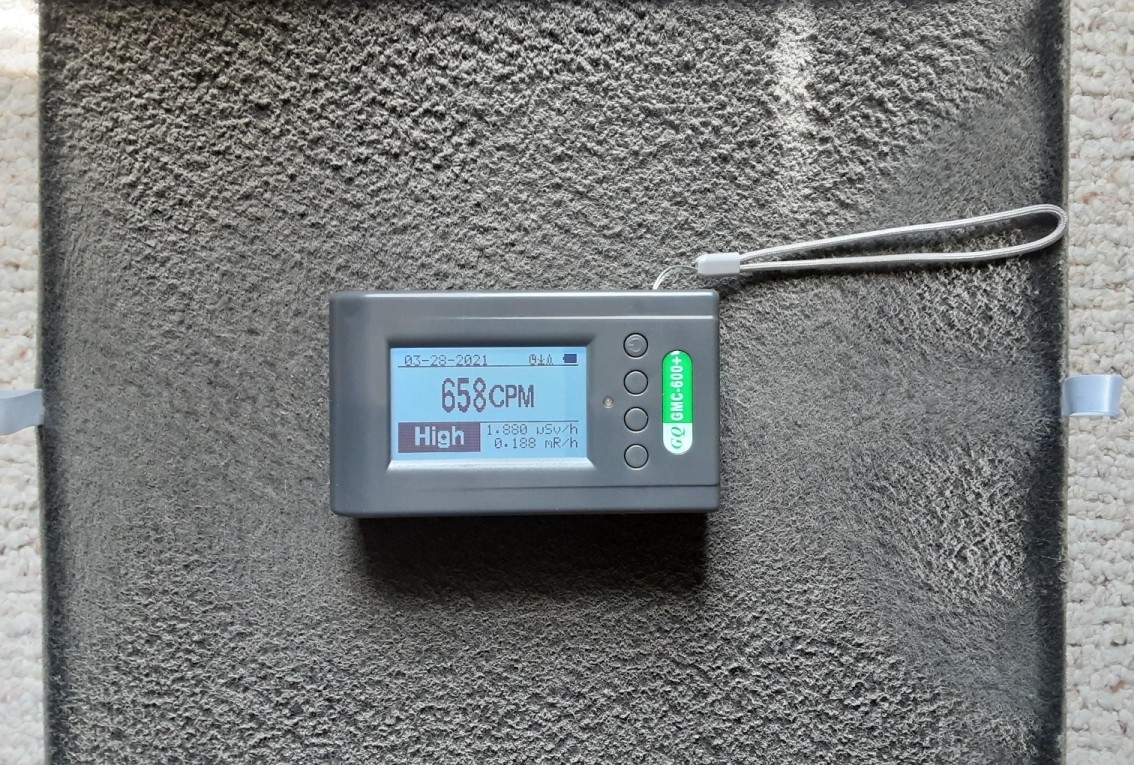
Does this look scary or is it just me?
Randy
|
A uranium atom is only three hydrogen diameters, but 238 times as massive. |
Edited by - Oldtron on 04/08/2021 11:30:29
|
|
| Reply #1
Damien68
    
France
780 Posts |
 Posted - 03/28/2021 : 12:17:55 Posted - 03/28/2021 : 12:17:55


|
I have the same kind of phenomena but less strong with my 500+ when I test the bag of my vacuum cleaner just after having passed it. in my case i just can see the beta or gamma so the sub-disintegrations of the daughter elements of radon, for you, with a 600+ there are chances that you can observe the radon directly which fixed to the dust and which produces alpha.
you can test your new filter after 3 or 4 days of use, but it should be tested quickly after turning off the ventilation.
 |
Mastery is acquired by studying, with it everything becomes simple |
Edited by - Damien68 on 03/28/2021 12:25:30 |
 |
|
| Reply #2
Oldtron
 
USA
22 Posts |
 Posted - 03/28/2021 : 14:13:29 Posted - 03/28/2021 : 14:13:29


|
Roughly 2 hours into the test, reading has dropped to 0.031 mR/h, 0.331uSv/h.
So it's decaying rapidly.
Aren't the isotopes the same as the Uranium-238 decay chain? (from radon down of course)
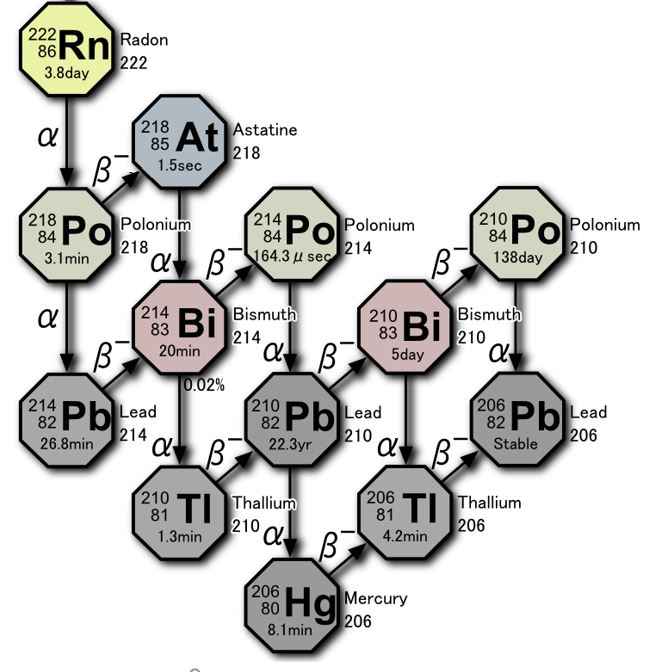
https://en.wikipedia.org/wiki/Radon#/media/File:Decay_chain(4n+2,_Uranium_series).svg
Randy
|
A uranium atom is only three hydrogen diameters, but 238 times as massive. |
 |
|
| Reply #3
ullix
    
Germany
1237 Posts |
 Posted - 03/31/2021 : 00:52:14 Posted - 03/31/2021 : 00:52:14


|
@Oldtron: Very nice experiment!
I am wondering whether you can present some more. I would like to see the time course of activity to get some info on the half life. Since you are seeing a decline within hours, this cannot be explained with just the half life of Rn222, which is 3.8days.
Can you do logging over a full day? Or a recording to internal memory and download. Preferably into GeigerLog, can this can also be done with doing a raw download first.
And onw suggestion: do NOT use uSv/h for reporting the dose rate. The "calibration" for mSv/h is valid only for gamma radiation, and even there only for a radiation for for exactly the energy source, for which the calibration was done. And this is not even known.
It clearly is wrong when you also have alpha and beta components, as is the case if you do indeed see Radon!
|
 |
|
| Reply #4
Oldtron
 
USA
22 Posts |
 Posted - 03/31/2021 : 12:10:30 Posted - 03/31/2021 : 12:10:30


|
Good day ullix,
Yes, I think I need at least a 12-hour sample to get a better picture of the decay, I’m trying to get back to it.
Not sure what you mean by the “reporting dose rate”. Unless you mean in using GeigerLog? Been trying to get there too. My Raspberry Pi 4, I believe had a corrupted file system from trying to load some other stuff using “pip”. I’ve rebuilt the operating system and will try to install GeigerLog again.
Unless I’m mistaken, calibration is a pretty loose term in these parts!
These instruments seem to be calibrated via a “theoretical/mathematical algorithm based on physics” (for lack of a better term). Some posters here on the forum have tested this calibration against other “calibrated” instruments and have shown an incredibly good correlation. However, as you know different radiation requires different calibration. So, using a GM tube that detects 4 different types of radiation which cannot be easily filtered for any one type leaves us in somewhat of a gray area.
I spent a few years calibrating photodiodes and phototransistors to NIST using a monochromator, this was straightforward. All my photons were in fact photons, different frequencies/energy levels but still the same particles. Obviously, this is not the case with Geiger counters.
Anyway, here is an Excel Graph of the data.
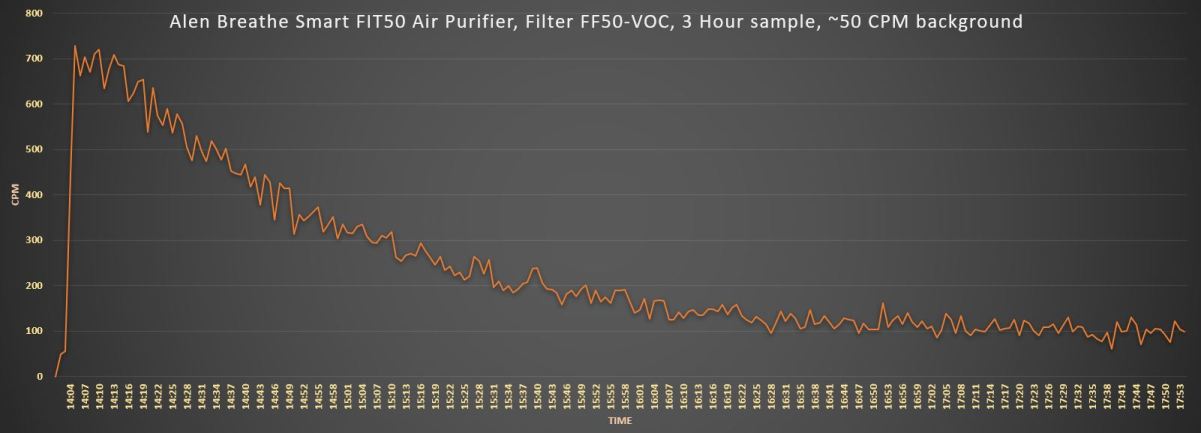
The only thing I’ve learned so far is it may be a good idea to wait a day or two before emptying the vacuum cleaner dust bin.
Randy |
A uranium atom is only three hydrogen diameters, but 238 times as massive. |
Edited by - Oldtron on 06/06/2021 19:07:04 |
 |
|
| Reply #5
Damien68
    
France
780 Posts |
 Posted - 04/01/2021 : 00:02:08 Posted - 04/01/2021 : 00:02:08


|
nice data,
removing 50CPM for the background, this shows a half-life of around 40 minutes:
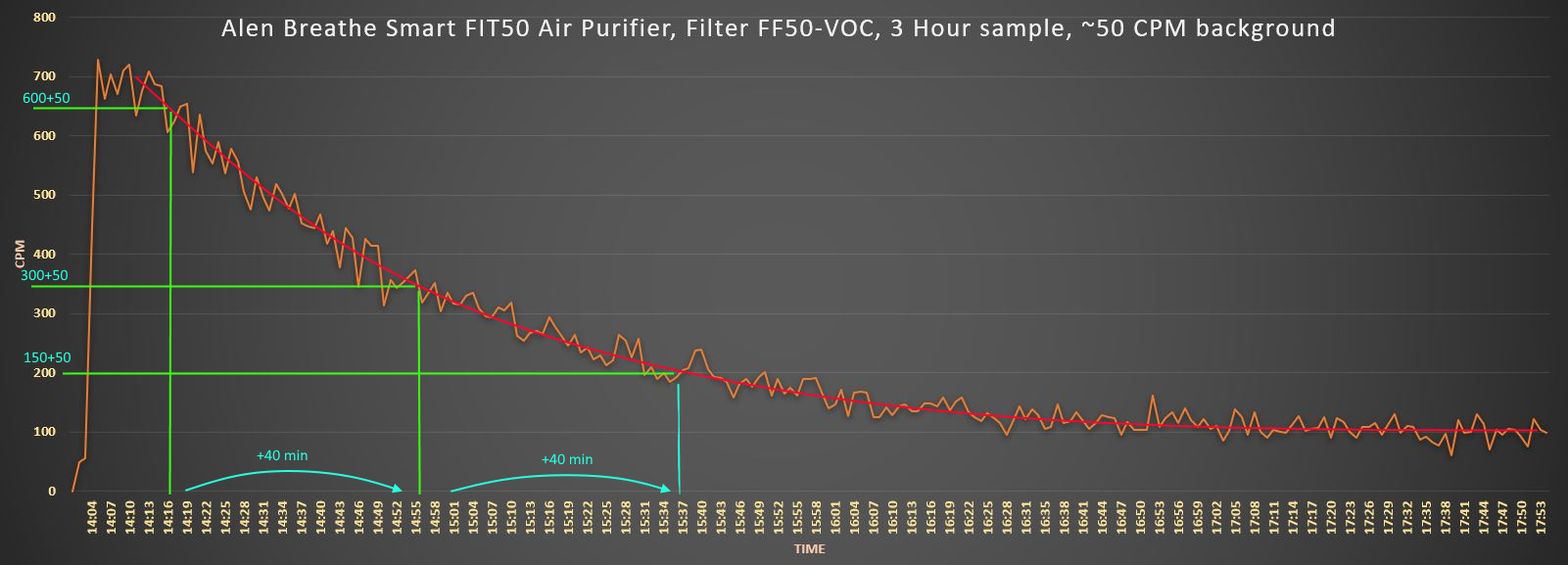
40 minutes approximately looks like (Po-218 or Pb214) to finaly Pb-210 element.
26.8min (Pb-214 to Bi-214) + 20 min (Bi-214 to (Ti-210 or Po-214))
on the graph I indicated 40 minutes but it is approximate, 46 minutes would be fine too
Pb-210 have 22.3years of half life so only very little radioactive
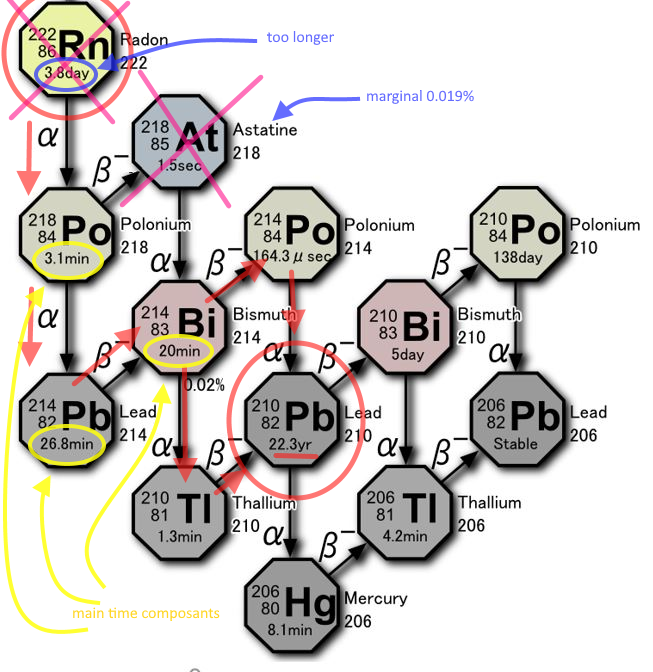
I will say that the filter must not fix radon but only the daughter products Po-218 + Pb-214 + Bi-214 + ...
if we had radon we would have a spread over 3.8 day, and no such rapid convergence towards the background rate
PS: I'm not sure if we can add subsequent half-lives time as easily as that, but since it's the same order of magnitude, 26.8 + 20, I will say that it must be an acceptable first approximation to refine. |
Mastery is acquired by studying, with it everything becomes simple |
Edited by - Damien68 on 04/01/2021 02:01:57 |
 |
|
| Reply #6
ullix
    
Germany
1237 Posts |
 Posted - 04/01/2021 : 02:09:03 Posted - 04/01/2021 : 02:09:03


|
@Oldtron: Just amazing :-), well done!
It is unclear to me where the air gets sucked into the system at your place: the air inlet is in the basement (and the basement has solid walls around it), or the air is taken from outside? It looks to me like a strong signal. Can you give the rough location in the US? Any volcanic activity around? Anything peculiar with respect to geology?
I suggest to re-plot the data as log(CPM) versus time[h]. This easily lets you read the half life, and also quickly tells you when you have more than one decay constant.
A rough estimate of half-life also gets me to 45min. I think this has nothing to do with radioactive decay, but with the disappearance of the Rn gas. Assuming, of course, it is Rn to begin with!
Trying to retain the gas creates some complexities. You could put it all in a plastic bag, but the counter won't be able to see any alphas floating somewhere in the bag. Perhaps it is best to eliminate alpha capability by putting the counter itself in a (thin) plastic bag, and relying on beta and gamma only? Some ingenuity required!
quote:
My Raspberry Pi 4, I believe had a corrupted file system from trying to load some other stuff using “pip”. I’ve rebuilt the operating system and will try to install GeigerLog again.
Yeah, they put some "convenience" into the Raspi OS, which does result in problems. Take a very close look at my Raspi-specific instructions in the GeigerLog manual!
Since you seem to be technically inclined, I strongly suggest to consider a Python Virtual Environment. Easier done than explained, see more here: https://sourceforge.net/projects/geigerlog/files/Articles/HOWTO%20-%20Using%20Python%20in%20a%20virtual%20Environment%20on%20Linux-v1.0.pdf/download
quote:
Not sure what you mean by the “reporting dose rate”.
Unless I’m mistaken, calibration is a pretty loose term in these parts!
The "dose rate" can be reported either as CPM, or as uSv/h. The latter is already an "interpretation" of your raw CPM data.
See e.g the SBM20 tube, which is specified as follows:
Sensitivity when calibrated against:
Ra226 174 CPM / (uSv/h)
Co60 132 CPM / (uSv/h)
See more in the GL manual, chapter Appendix G – Calibration.
It is up to the interpretation of the experimenter to take either 132 or 174, or even something different. It is different because of the energy dependent sensitivity of the Geiger counter principle, and the very different energy spectrum of those two sources.
I don't see "calibration" as a loose term; it is well defined. However, the "loose" part clearly sets in with the use of it in all situations, whether appropriate or not. Using one single "calibration factor" will be wrong most of the time. It is ALWAYS wrong when used in situations where beta or alpha are present!
|
Edited by - ullix on 04/01/2021 02:11:13 |
 |
|
| Reply #7
Damien68
    
France
780 Posts |
 Posted - 04/02/2021 : 03:10:04 Posted - 04/02/2021 : 03:10:04


|
I think all the radon must have escaped the filter during the first 10 minutes of recording and before.
some HEPA filters are electrosatically charged to increase their filtration power, not necessary for that but once disassembled it would not be surprising if all the radon escapes quickly.
@Oldtron: What you can do is to mesure the activity of you filter 1 month after use it, this will give you the activity of residual Pb-210 accumulated in your filter.
with aproximate calculation, if your filter catches radon gas at a continuous observable level of 700CPM for an entire year, the activity of accumulated Pb-210 on your filter should be approximately 10 CPM during 22 years this must be observed by taking a long measurement. but you may actually have more than 700 CPM.
Pb-210 activity could explain why on your graph the CPMs converge more towards 80-90 CPM than towards 50CPM which is your background.
Rn-222 -> Pb-210 : 5 decay
Pb210 -> Pb206 : 3 decay
After 1 years of accumulation of Pb210:
700 CPM x (3decay/5decay) x (1 year /22.3 years) /2 = 10 CPM (first order approximation considering 1 year small in front of 22.3 years)
This is only a instinctive calculation to check/prove.
|
Mastery is acquired by studying, with it everything becomes simple |
Edited by - Damien68 on 04/02/2021 03:22:38 |
 |
|
| Reply #8
Damien68
    
France
780 Posts |
 Posted - 04/02/2021 : 08:45:15 Posted - 04/02/2021 : 08:45:15


|
against radon, it is necessary to seal all the entries that there may be between the foundation of the house and the living rooms.
Otherwise, it is important to ventilate regularly. |
Mastery is acquired by studying, with it everything becomes simple |
Edited by - Damien68 on 04/02/2021 09:05:14 |
 |
|
| Reply #9
Oldtron
 
USA
22 Posts |
 Posted - 04/02/2021 : 13:13:42 Posted - 04/02/2021 : 13:13:42


|
Wow, Thanks to all,
This is remarkably interesting…
Damien68, your analysis of the data is right along the lines I was thinking, nice job!
ullix, I’m eager to get your software up and running, soon I promise.
To answer some questions:
The filter was in operation for approximately 9 months 24-7, not electrostatic, but contains around 5 Lbs. of activated charcoal. The unit does have an ionizer in operation. It expels positive and negative ions at some interval to get dust particles to cling together for more efficient filtering.
Thinking of testing the new filter every month for 12 hours just to see what we get.
https://www.radon.com/home/: States the radon levels for our county as follows:
Average Radon Level: 3.6 pCi/L
Results above 4.0 pCi/L: 27.3%
Results above 2.0 pCi/L: 56.4%
Our foundation is 8-foot concrete walls and floor with no significant cracks.
The real entry point is most likely the Sump Pump. With drain lines running all the way around the foundation and terminating in the sump, this is a great collector of radon. The sump pump cover is a joke. Blow molded plastic cover has a huge hole in it for the power cord and output pipe(chalk one up for US building codes). One website suggested sealing the sump! They don’t seem to realize if air can’t get out, then water can’t in, defeating the purpose of the thing! A second pipe through the foundation would be required for a vent or tied to one of the sewer drain vent pipes going through the roof.
Here in Missouri were setting on limestone bedrock. I assume most of the radioactive elements are below this layer. One of my hobbies being Karst Hydrology, I believe the cave systems around the Mississippi river basin could carry radon’s byproducts thousands of miles underground. This could create a hot spot almost anywhere. Just as our sinkholes can popup anywhere!
Something I don’t feel knowledgeable enough on are these Decay Chain Charts. If anyone has reference to any good reading material point me in the right direction. Basically, there easy to understand, except for the little details. Take 214/83 Bismuth, what factors are involved in whether there will be an alpha or beta decay(besides time)? And what is the 0.02% on the alpha line, probability of alpha decay? And why is that the only percentage on the chart?
Randy
|
A uranium atom is only three hydrogen diameters, but 238 times as massive. |
 |
|
| Reply #10
ullix
    
Germany
1237 Posts |
 Posted - 04/03/2021 : 00:54:12 Posted - 04/03/2021 : 00:54:12


|
Thanks for the helpful Radon link. Looking though it, I am not seeing much out of the ordinary in Missouri?
Learning about the "decay chain" is a bit of a challenge. Google gives 80 Mio results ;-). You might just as well start with Wikipedia:
https://en.wikipedia.org/wiki/Radioactive_decay
and then follow the specifics on decay chain:
https://en.wikipedia.org/wiki/Decay_chain
The WHO handbook specific to Radon may also be helpful:
h**p://whqlibdoc.who.int/publications/2009/9789241547673_eng.pdf
A nucleus' decision to decay either via alpha, or beta, or gamma is taken by the nucleus itself. It is a random thing, though on average a very precise ratio is maintained. You can also see it on easier to comprehend isotopes, like K40, which either decays via gamma or beta. See my Potty Training.
Radon may result from three different decay chains: Rn222 (from Uranium), Rn220 (from Thorium), Rn219 (from Actinium). The respective decay pattern and energies will look different, and we don't know which one it is in your case (if it even is Radon in the first place!).
There is one thing I would like to point out:
Assuming - for simplicity - you start with Rn222 which has a half life of 3.8 days, then you CANNOT see any of the shorter half lives from the daughter atoms, which range from microseconds to minutes! Rn222 will look like decaying by everything, alpha, beta, (and gamma; I believe the chart is not complete).
In this specific decay chain the next stop with a longer half life is Pb210 (22 years), and even if you wanted to measure it for at least several months, you couldn't keep the Radon in place, because it is a gas.
One suggestion: determine whether you see any alpha decay at all. For that wrap the counter in a thin (kitchen) plastic foil, and measure with and without.
|
 |
|
| Reply #11
Damien68
    
France
780 Posts |
 Posted - 04/03/2021 : 00:58:40 Posted - 04/03/2021 : 00:58:40


|
quote:
Originally posted by Oldtron
Something I don’t feel knowledgeable enough on are these Decay Chain Charts. If anyone has reference to any good reading material point me in the right direction. Basically, there easy to understand, except for the little details. Take 214/83 Bismuth, what factors are involved in whether there will be an alpha or beta decay(besides time)? And what is the 0.02% on the alpha line, probability of alpha decay? And why is that the only percentage on the chart?
Randy
Hello Randy,
For Bi-214, there are two decay chain possible ways:
1. issue an alpha followed by a beta to arrive at Pb-210.
2. issue an beta followed by a alpha to arrive at same Pb-210.
in case of Bi-214 both are possible. but there is no factor that will influence it. it's just an observed probability.
On some decay chain representation, in case of multiple decay possibility, sometimes it indicate the percentages/probabilyty of every way, other times not, sometimes it remove the decay which are not very probable.
about the time that is indicated for each element:
this is the half-life time of the element in question.
it must be understood that each unstable element has a constant probability density (independent of everything) of decay, and this at any time (of course as long as it has not already decayed).
this probability density depends only on the nature of the element (Rn-222, Po-218, ...).
also if we integrate this probability density (which is constant) over a time equal to the half-life of the element, we obtain a probability equal to 1/2.
which is equivalent to saying that if an element is in an unstable state at an instant (T0), the probability that it decay in the interval time [T0, T0 + his halfLife] is equal to 1/2, this whatever T0.
|
Mastery is acquired by studying, with it everything becomes simple |
Edited by - Damien68 on 04/03/2021 05:50:30 |
 |
|
| Reply #12
Damien68
    
France
780 Posts |
 Posted - 04/03/2021 : 01:08:31 Posted - 04/03/2021 : 01:08:31


|
quote:
Originally posted by ullix
In this specific decay chain the next stop with a longer half life is Pb210 (22 years), and even if you wanted to measure it for at least several months, you couldn't keep the Radon in place, because it is a gas.
Hi Ullix,
For me radon is a mono atomic gas, so once decayed after 3.8 day it is no longer radon, no longer gas but becomes metal lead (Pb-210) and it must drop off and stay in place permanently because it have more stronger intermolecular forces.
what do you think of that? |
Mastery is acquired by studying, with it everything becomes simple |
Edited by - Damien68 on 04/03/2021 06:50:44 |
 |
|
| Reply #13
Damien68
    
France
780 Posts |
 Posted - 04/03/2021 : 01:24:31 Posted - 04/03/2021 : 01:24:31


|
quote:
Originally posted by ullix
There is one thing I would like to point out:
Assuming - for simplicity - you start with Rn222 which has a half life of 3.8 days, then you CANNOT see any of the shorter half lives from the daughter atoms, which range from microseconds to minutes! Rn222 will look like decaying by everything, alpha, beta, (and gamma; I believe the chart is not complete).
Why?
is this a reference to the tube's deadtime?
If it, it only potential issue can be distort the result very slightly.
the issue can be around Po-214 to Pb-210 decay with it halflife of 164uS.
To make potential distortion it would be necessary that the two particles of the two closely consecutive decays coming from the same nucleus cross the tube, already there the probability is low.
I made a fast calculation based on experimentation with my 500+ and K40.
http://www.gqelectronicsllc.com/forum/topic.asp?TOPIC_ID=9114&SearchTerms=salt
see reply 2
The conclusion was to say that with my GMC-500, I detected only 0.03% of the particles emitted by the K40 which was in front of my reader (it's not bad and very consistent).
now we are not in the same context at all, but I think the probability that the second closely consecutive decays particule cross the tube after the first coming from the same nucleus crossed it, is weak (<0.1)
PS: it's a bit more complex but it's a first aproximation
the time between the 2 decays should also be less than the real dead time of the tube: the probability is around 0.5.
and this will only possibly hide a detection over the fives (Rn-222 to Pb-210).
so with these figures, the potential distortion is around 0.1 x 0.5 x 0.2 = 1%
quote:
Originally posted by ullix
A nucleus' decision to decay either via alpha, or beta, or gamma is taken by the nucleus itself.
yes and at the same time or just after an alpha or beta emission there can have a gamma emission to rebalance the quantum energy/configuration of the nucleus if it finds himself in an excited state, gamma emission is mentioned on some chart but not on all.
I found more complet chart with all percent:
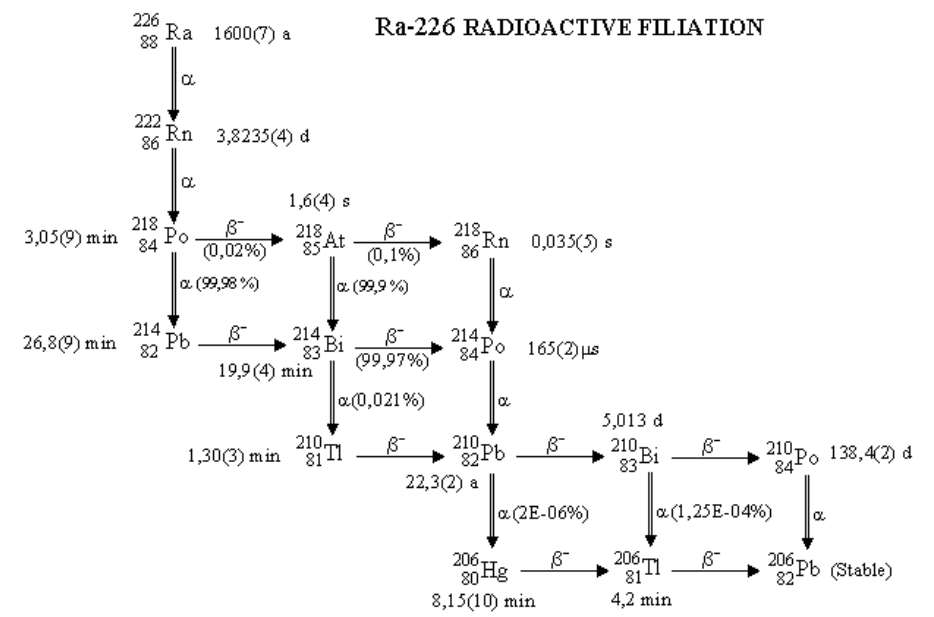 |
Mastery is acquired by studying, with it everything becomes simple |
Edited by - Damien68 on 04/03/2021 08:55:27 |
 |
|
| Reply #14
Oldtron
 
USA
22 Posts |
 Posted - 04/07/2021 : 11:13:18 Posted - 04/07/2021 : 11:13:18


|
Attempted a 12-hour sampling of the new filter, noticed during one check the count seems to be really high(around 1200 CPM I think), which didn’t make any sense, but I had other things to do so I let it run.
Attempted to download data: Nightmare… Data Viewer would crash shortly after download began. After about 30 min. of trying various things, I finally got the thing to save a .bin file, no .csv to be found anywhere.
Attempted to open .bin file, Data Viewer crashes!
Un/reinstalled Data Viewer.
Attempted to open .bin file, Data Viewer crashes!
Opened an earlier .bin file everything worked.
Back to the new .bin file, it finally opened. Saved as .csv file.

Erased all data files/history in the unit. Downloaded configuration file from unit, everything looks fine.
Preformed 1 hour test on Uranium Glass, downloaded and processed data, everything looks perfect.
Started another 12-Hour on the new filter. After a while I checked the status and found both dosage readings read -0.000 with a count over 700 CPM. Terminated test!
Downloaded configuration file from unit, again! Not so good! And this time there was no USB communication to cause a malfunction (like I thought may have happen the first time).
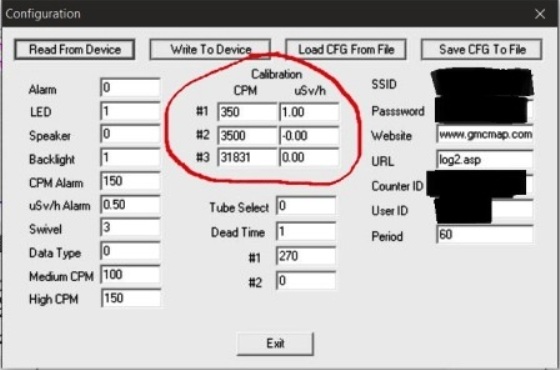
Geiger Counter or Paperweight, that is the question!
I’m leaning towards a $300 paperweight.
Performed factory reset and reprogramed, again!
Repeated 12-hour test.
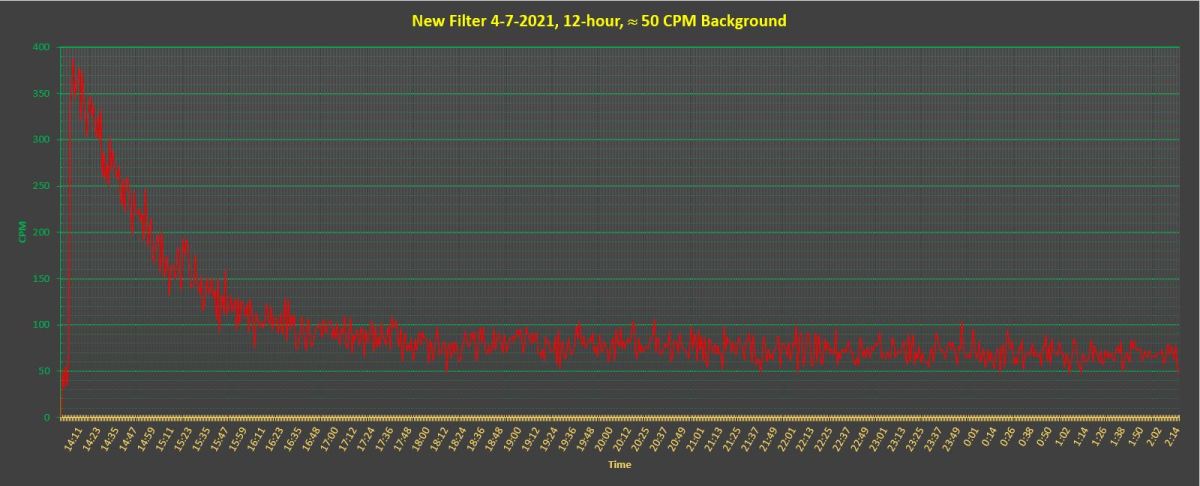
This time it worked.
Am I the only one with a 600+ that corrupts its own data/memory?
I have never even heard of a digital circuit acting like this before. If I didn’t know better(and I don’t) I’d swear the radiation is doing something to the circuitry. Perhaps in combination with soft ESD damage in one of the chips?
All I can think of is to return the unit to GQ and see if they can reproduce the problem…
Randy
4/8/21 1:00PM CST Edited Image Size...
|
A uranium atom is only three hydrogen diameters, but 238 times as massive. |
Edited by - Oldtron on 04/08/2021 10:01:51 |
 |
|
| Reply #15
Damien68
    
France
780 Posts |
 Posted - 04/07/2021 : 11:57:39 Posted - 04/07/2021 : 11:57:39


|
Hi Oldtron,
the corruption of your configuration data must be done by the Dataviewer software it may be writing or overwriting the configuration in flash memory with bogus data. It can also come from the counter, but not too much from the USB cable because all transactions via USB (in this mode) are secure, it works or it does not.
1200 CPM I wouldn't be surprised if this is normal CPM rate in operation. It does not seem to me exaggerated given the residue that we have subsequently. here with the new filter you converge towards 70CPM which is 20 more than your background.
but it is possible that there is a little radon left in the activated carbon, which is why it would be interesting to test the filter 1 or 2 months later or more.
during recording, the observed decroissance on your data is the same (-50% each 45 minutes).
|
Mastery is acquired by studying, with it everything becomes simple |
Edited by - Damien68 on 04/07/2021 12:40:46 |
 |
|
| Reply #16
Oldtron
 
USA
22 Posts |
 Posted - 04/07/2021 : 12:52:12 Posted - 04/07/2021 : 12:52:12


|
quote:
Originally posted by Damien68
Hi Oldtron,
the corruption of your configuration data must be done by the Dataviewer software it may be writing or overwriting the configuration in flash memory with bogus data.
Damien68, I don’t think that’s what I’m seeing.
It looks like the data became corrupt in the 600+ itself. The Data Viewer appeared to be crashing because it was either reading or saving(saving I’m fairly sure) something it wasn’t programed to deal with. Bad checksum, wrong data type in the wrong place, etc. No error pop-up or anything, the Data Viewer just closed. I obtained the same results after reinstalling the Data Viewer.
Right! USB "Should" either work or not.
And software shouldn't do random things.
Randy
|
A uranium atom is only three hydrogen diameters, but 238 times as massive. |
 |
|
| Reply #17
Damien68
    
France
780 Posts |
 Posted - 04/07/2021 : 22:25:00 Posted - 04/07/2021 : 22:25:00


|
you can try the Data logger PRO version in demo mode, maybe there is a bug in the Dataviewer related to the 600+.
otherwise erase the history, do a factory reset, switch off the legacy output. make several espresso :)
hoping that this is not a hardware problem kind slight offset on the CPU clock frequency.
|
Mastery is acquired by studying, with it everything becomes simple |
Edited by - Damien68 on 04/07/2021 22:31:29 |
 |
|
| Reply #18
ullix
    
Germany
1237 Posts |
 Posted - 04/07/2021 : 23:16:12 Posted - 04/07/2021 : 23:16:12


|
@oldtron: Show that it also fails with GeigerLog; until then I believe it is a Dataviewer problem ;-)
Until that time: could you please make the *.bin file available? Can also send via email from the forum or from GeigerLog Discussion on SourceForge https://sourceforge.net/p/geigerlog/discussion/
P.S. please make your pictures smaller before posting; it is cumbersome to view :-/ |
 |
|
| Reply #19
Oldtron
 
USA
22 Posts |
 Posted - 04/08/2021 : 11:28:21 Posted - 04/08/2021 : 11:28:21


|
Damien68 & ullix,
Know what, you guys may me right!
I got bored late last night and decided to play with the Data Viewer, and I mean as harshly as I could(debugging)!
Found one bug for sure!
(Someone here on the form I believe already noticed this, but I can’t find the post right now. Edit: Found it.)
https://www.gqelectronicsllc.com/forum/topic.asp?TOPIC_ID=9516
GQ GMC Date Viewer not fully compatible with 600+
Want to see the BUG?
1. Attach unit (600+ in my case) to USB port.
2. Open Data Viewer, let it connect to device.
3. Check the Realtime Monitoring Checkbox(here lays the problem).
4. Select: Setting, Other.
5. Under section “Geiger Counter Wi-Fi Data Setup”. Select: “Read From Device”.
6. You should find the text boxes filled with garbage.
The problem should be obvious. One can’t use the same serial buss for two different functions at the same time without some careful consideration. The data must be “forced through the port and the buffer flushed” before the next function uses the port. There are commands like, “Is port available” and “Is data ready” I’m sure the programmer knows this, but stuff happens.
While playing with the Data Viewer, with Realtime Monitoring Checkbox checked, and jumping to various items under the Setting Menu I was able to create these:
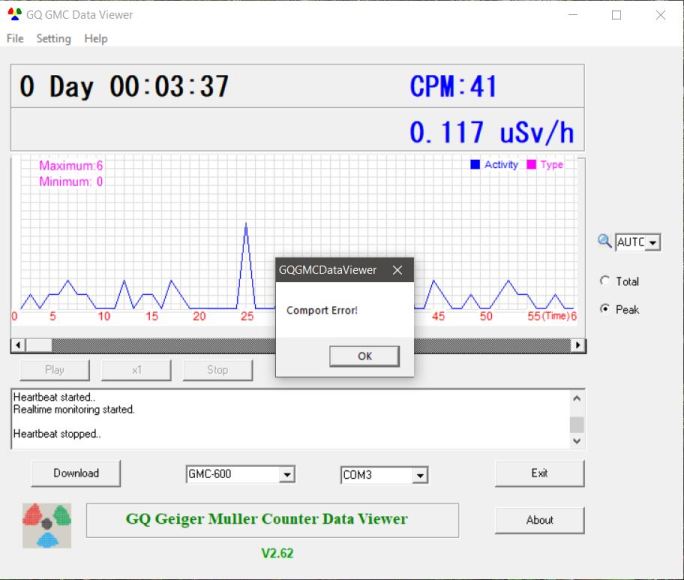
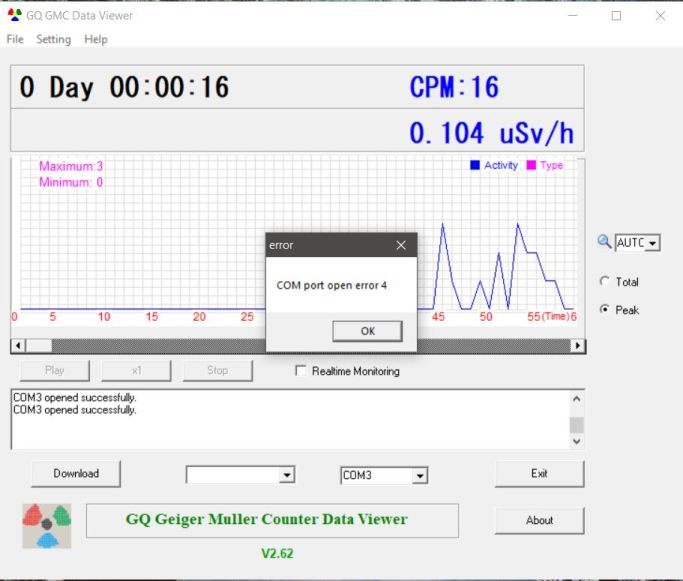
I should not be able to cause these errors just by pushing buttons, the serial port is not being handled correctly. Sorry, but that appears to be the case.
Whether or not this is what is causing my data corruption, I don’t know, it’s probable, but hard to prove until the Data Viewer is fixed.
Randy
|
A uranium atom is only three hydrogen diameters, but 238 times as massive. |
Edited by - Oldtron on 04/08/2021 18:17:44 |
 |
|
| Reply #20
Damien68
    
France
780 Posts |
 Posted - 04/09/2021 : 00:02:16 Posted - 04/09/2021 : 00:02:16


|
I have worked a lot on data transmission, point to point or in networks, wire or wireless,
It would be easier if GQ used a real data framming to encapsulate the data as much at the level of the recording of the history in the flash, as much at the level of the data transmission by the UART.
true data framming = SOF + ID + Len + Datas + CRC + EOF, this with control characters + escape sequences.
Len, CRC and EOF can be optional.
implicitly for flash recording 0xFF is end of writed memory and EOF is not required.
afterwards we can be satisfied with a simpler solution as they did but it is very much more complicated to manage and require multiples sanity checks and a full espresso cartridge box , but is not impossible. , but is not impossible. |
Mastery is acquired by studying, with it everything becomes simple |
Edited by - Damien68 on 04/09/2021 00:36:31 |
 |
|
| Reply #21
ullix
    
Germany
1237 Posts |
 Posted - 04/09/2021 : 06:21:32 Posted - 04/09/2021 : 06:21:32


|
Oldtron, thanks for the *.bin file. Which file is it: the one which even Dataviewer could read, or the one which crashed it? It could be read into GeigerLog without any problems. It is similar if not the same as what you posted in Reply#14.
Loading into GeigerLog is done via menu: "History --> GMC Series --> Get History from GMC Binary File ...". Then it is shown:

The parsing actions done by GL can be also shown from the menu: "History --> Show History Data with Parse Comments". Here an except, showing also the counter's protocol on its activities:
==== Show History Data with Parse Comments ===========================================
# Index, DateTime, CPM, CPS, CPM1st, CPS1st, CPM2nd, CPS2nd, ParseInfo
# HEADER, , File created from History Download Binary Data
# ORIGIN, , Downloaded <Date Unknown> from device '<Device Unknown>'
# 0, 2021-04-06 13:59:48, Date&Time Stamp; Type:'CPS, save every second', Interval:1 sec
12, 2021-04-06 13:59:49, 1.0, 1.0, , , , , ---single digit---CPS, save every second
13, 2021-04-06 13:59:50, 1.0, 0.0, , , , , ---single digit---CPS, save every second
14, 2021-04-06 13:59:51, 4.0, 3.0, , , , , ---single digit---CPS, save every second
...
46978, 2021-04-07 02:17:02, 40.0, 0.0, , , , , ---single digit---CPS, save every second
46979, 2021-04-07 02:17:03, 41.0, 2.0, , , , , ---single digit---CPS, save every second
# 46980, 2021-04-07 02:17:04, Date&Time Stamp; Type:'CPS, save every second', Interval:1 sec
46992, 2021-04-07 02:17:05, 41.0, 0.0, , , , , ---single digit---CPS, save every second
# 46993, 2021-04-07 02:17:05, Date&Time Stamp; Type:'CPM, save every minute', Interval:60 sec
# 47005, 2021-04-07 02:17:06, Date&Time Stamp; Type:'CPM, save every hour as hourly average', Interval:3600 sec
# 47017, 2021-04-07 02:17:06, Date&Time Stamp; Type:'CPS, save every second if exceeding threshold', Interval:1 sec
# 47029, 2021-04-07 02:17:06, Date&Time Stamp; Type:'CPM, save every minute if exceeding threshold', Interval:60 sec
# 47041, 2021-04-07 02:17:07, Date&Time Stamp; Type:'history saving off', Interval:0 sec
Note that only 'CPS, save every second' data were saved, and are shown in the graph in Magenta color. The CPM data are calculated by GL and are shown in Dark Blue. As CPM sums up the last 60 CPS value, upon starting, and when changing count rate, the first 59 CPM values will necessarily always be incomplete; thus the rising blue line at the left edge.
It is always a good idea to use 'CPS, save every second' when you expect fast changes, but in retrospect a 'CPM, save every minute' would have sufficed just as well (and fewer data would have had to be handled).
When seeing a radioactive decay, it should always be one of the first steps to look at a log-lin plot. You can do this in GL via the Graph-Toolbar:

The upward flash (2nd from right) allows to select the Counter Y-axis and set it to logarithmic, as shown in the next pic.
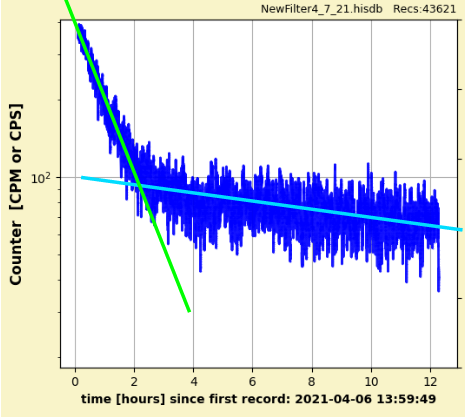
In the log-plot you now also notice that you do not have just one exponential component, but (at least) two, which I have marked with
light green for the fast, and light blue for the slow component.
Unfortunately, were there only one component, you could have used the mouse in GL to read out the coordinates, calculate the slope on a calculator, and had gotten the half life time. But with two such components the GeigerLog service ends here, and you need to move into a spreadsheet.
So I imported the data prepared by GL and imported them into LibreOffice Calc. Not having a dedicated 2-component exponential fitting routine, I resorted to "Best-Eye-Fits", i.e. I modified the parameters of an exponential curve manually until I was satisfied with what I saw:
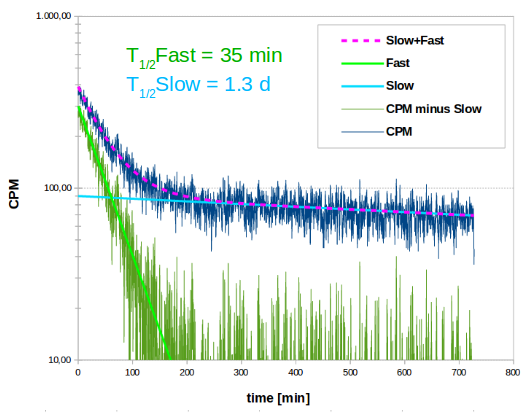
Remember to follow these steps:
1) determine the fit (light blue) to the slow component of the CPM data (dark blue)
2) calculate the fast part data (dark green) as dark blue minus light-blue fit
3) determine the fit (light green) to the fast component
4) calculate the overall fit (dashed magenta) by taking the sum of the light blue and light green fits.
Fit looks good, giving no reason to assume a 3rd component. The fast half life of 35 min does not correspond to any radioactive decay; it is probably release of Radon from the filter matrix. The slow half-life of 1.3 d is a bit closer to the 3.8 d of Rn222, maybe a longer measurement would reveal it?
However, we have made a mistake. We actually do have a 3rd component to consider, which is the background. Think of it as a 3rd exponential with an infinite half-life. We'll have to subtract this first. It cannot be read from the present data, as the CPM is still falling a the end. However, I believe Oldtron reported it as CPM=50, so I used that and repeated the analysis, as shown next:
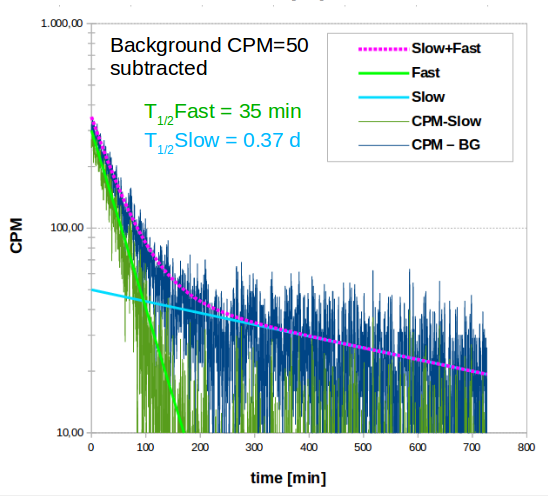
Now the fast half life is unchanged, but the slow one has dropped from 1.3 d to only 0.37 d. Even if 50 were not the correct background, nothing significant would change. Thus the slow component is not Rn222 decay; perhaps another desorption constant?
Suggestion: According to WHO, long term Radon measurements use "activated charcoal". If this is available as filter matrix, it may be worth a trial to have Rn bound more tightly to the filter. Then measure for longer time, and in CPM mode.
P.S. As Mark Twain said: "One gets such wholesale returns of conjecture out of such a trifling investment of fact." I had no idea he knew about Geiger counters ;-)
|
Edited by - ullix on 04/09/2021 06:22:14 |
 |
|
| Reply #22
Oldtron
 
USA
22 Posts |
 Posted - 04/09/2021 : 11:16:46 Posted - 04/09/2021 : 11:16:46


|
quote:
Originally posted by ullix
Oldtron, thanks for the *.bin file. Which file is it: the one which even Dataviewer could read, or the one which crashed it? It could be read into GeigerLog without any problems. It is similar if not the same as what you posted in Reply#14.
Ullix, Yes that’s the good data same as reply#14. The bad data would look something like a highly exaggerated saw-tooth wave.
quote:
Originally posted by ullix
Note that only 'CPS, save every second' data were saved, and are shown in the graph in Magenta color. The CPM data are calculated by GL and are shown in Dark Blue. As CPM sums up the last 60 CPS value, upon starting, and when changing count rate, the first 59 CPM values will necessarily always be incomplete; thus the rising blue line at the left edge.
The rising line at the left is because of how I took the reading, sorry I probably should have explained this sooner.
I take the filter out and lay it flat with the schedule set for like 3 min. Then I stand there like an idiot away from the filter until the count has started. I let it run for ~1 min. to record the background, then set the unit on the filter.
Look closely at the beginning of the line, that little wiggle at ~50 CPM is the background radiation.
I do it that way for the “warm and fuzzy” that the unit is functioning correctly just before I start the actual test, especially a 12-hour one.
I have two Radon test kits being delivered tomorrow so I’ll have that data in a week or so and we’ll see if all this means anything.
Randy
|
A uranium atom is only three hydrogen diameters, but 238 times as massive. |
 |
|
| Reply #23
Damien68
    
France
780 Posts |
 Posted - 04/10/2021 : 07:22:36 Posted - 04/10/2021 : 07:22:36


|
Hi ullix,
you must be largely right,
the slopes do not correspond to something logical with respect to atomic decays.
we must have, as you say, a good part of radon evaporation in place in the filter.
In my opinion, there will still be some decomposition elements in the filter, but these are not the ones we see in the foreground.
I found an interesting article on the subject, see the second speaker:
https://www.researchgate.net/post/Why-or-how-does-Radon-adsorb-onto-activated-carbon
|
Mastery is acquired by studying, with it everything becomes simple |
 |
|
| Reply #24
ullix
    
Germany
1237 Posts |
 Posted - 04/11/2021 : 00:39:00 Posted - 04/11/2021 : 00:39:00


|
Yeah, there is a whole bunch of options for a Radon atom to get caught in the filter and get away from it.
First we'll have to distinguish between Adsorption and Absorption. The first is the sticking of Rn to the surface of e.g. the filter or a dust particle in the air. The second is the moving of Rn into the volume of something. This could be a water droplet (aerosol), or even a solid like the fiber and the glue between fibers of the filter material.
Aerosols and dust could then be adsorbed onto the filter material, or they could be kind of sieved-out by the filter. Thus interaction could be plain mechanical, or electrostatic, or by dipole (van-de-Waals) forces, or by all of the above, plus anything we haven't thought off.
Chemical interaction is generally also possible, but since Radon is a noble gas, which doesn't like to bond with anything, not very likely.
Somewhat funny, but while there are two similar but different words for the moving-in or moving-onto process, there is only one word - Desorption - for the getting-out / getting-away process.
Good luck figuring out what it is!
|
 |
|
| Reply #25
Damien68
    
France
780 Posts |
 Posted - 04/11/2021 : 01:29:33 Posted - 04/11/2021 : 01:29:33


|
yes, and in addition, the filter in question is a mattress with different layers made of materials of different nature.
If radon can be captured by any different materials inside this filter, this also can explain why we have several "non-atomic" slopes of decreases superimposed.
 |
Mastery is acquired by studying, with it everything becomes simple |
Edited by - Damien68 on 04/11/2021 01:52:43 |
 |
|
| Reply #26
EmfDev
    
2379 Posts |
 Posted - 04/12/2021 : 10:18:45 Posted - 04/12/2021 : 10:18:45


|
| Hi Oldtron, are you using the 2.62 Revision Data Viewer? |
 |
|
| Reply #27
Oldtron
 
USA
22 Posts |
 Posted - 04/12/2021 : 20:51:01 Posted - 04/12/2021 : 20:51:01


|
quote:
Originally posted by EmfDev
Hi Oldtron, are you using the 2.62 Revision Data Viewer?
@EmfDev, Yes I am. Look at the bottom of the Data Viewer image above in Reply #19.
Randy
|
A uranium atom is only three hydrogen diameters, but 238 times as massive. |
 |
|
| Reply #28
Oldtron
 
USA
22 Posts |
 Posted - 04/12/2021 : 21:04:53 Posted - 04/12/2021 : 21:04:53


|
quote:
Originally posted by Damien68
we have several "non-atomic" slopes of decreases superimposed.
I got WHAT in my filter?
I know what your saying...
Filters first surface is ~4mm Felt, behind that is the usual HEPA White pleated material(can't tell how deep). Then from the back side one can see a honeycomb structure where I assume the charcoal is.
Randy |
A uranium atom is only three hydrogen diameters, but 238 times as massive. |
 |
|
| Reply #29
ullix
    
Germany
1237 Posts |
 Posted - 04/12/2021 : 23:56:10 Posted - 04/12/2021 : 23:56:10


|
@Oldtron: Oh, your filters already have a charcoal layer? Could you post a link to the device(s) you are using and the filters?
Makes me wonder what happens when you use such same filter but without the charcoal?
|
 |
|
| Reply #30
Oldtron
 
USA
22 Posts |
 Posted - 04/13/2021 : 12:52:21 Posted - 04/13/2021 : 12:52:21


|
quote:
Originally posted by ullix
@Oldtron: Oh, your filters already have a charcoal layer? Could you post a link to the device(s) you are using and the filters?
@ullix,
read lines 1 & 3 in the first post of this thread.
@EmfDev,
Don’t know if it will help, but here is the applicable software on my system. You may be able to tell if your software is using the wrong library, just a thought.

In Reply #19 “Want to see the BUG?” That procedure fails every time regardless of the comm port I use on my PC.
If I don’t check “Realtime Monitoring Checkbox” the “Geiger Counter Wi-Fi Data Setup” will contain the correct data.
If I do check “Realtime Monitoring Checkbox” the “Geiger Counter Wi-Fi Data Setup” will contain garbage.
Randy
|
A uranium atom is only three hydrogen diameters, but 238 times as massive. |
 |
|
| Reply #31
EmfDev
    
2379 Posts |
 Posted - 04/13/2021 : 16:20:16 Posted - 04/13/2021 : 16:20:16


|
| We will check this one. It used to turn off the Realtime monitoring when you go to the settings because the realtime monitoring turns on the automatic CPS/M sending (Heartbeat) from the device. That might be the reason why the data is wrong. The heartbeat was not turned off when navigating through the wifi setup. |
 |
|
| Reply #32
ullix
    
Germany
1237 Posts |
 Posted - 04/14/2021 : 00:26:43 Posted - 04/14/2021 : 00:26:43


|
It does look like the essential part of this Radon capturing is really the activated charcoal.
Here is a recent (2018) publication https://www.sciencedirect.com/science/article/abs/pii/S1350448718303779 underlining this. To quote from the text:
quote:
In the early part of the twentieth century, Rutherford (1906, 1909) used activated charcoal to adsorb radon gas to control laboratory contamination
So good old Rutherford already knew. Some 100 years later we are catching up ;-))
I interpret the "half-lifes" in Oldtron's data as out-gassing from the charcoal filter material, with the main component about 1/2 hour. Thus it would seem that one can collect Radon by putting the used filter in a suitable plastic bag, and then measure counts from the outside. I wouldn't put the counter inside, as this might result in a contamination of the counter by Radon decay products, though it would be only a minor contamination. Of course, since we then cannot see alphas, one would have to establish the count rate one sees through plastic. I am sure there will be enough.
|
 |
|
| Reply #33
Oldtron
 
USA
22 Posts |
 Posted - 04/14/2021 : 04:51:17 Posted - 04/14/2021 : 04:51:17


|
quote:
Originally posted by EmfDev
The heartbeat was not turned off when navigating through the wifi setup.
Hello EmfDev,
That’s exactly what I was trying to convey in Reply#19
I just hope the calibration data corruption I’ve been experiencing is being caused by the same issue. Otherwise, we may have two problems.
Anything I can do to help, just ask.
Thanks a bunch!
Randy
|
A uranium atom is only three hydrogen diameters, but 238 times as massive. |
 |
|
| Reply #34
Damien68
    
France
780 Posts |
 Posted - 04/19/2021 : 06:37:44 Posted - 04/19/2021 : 06:37:44


|
I did a test by placing a homemade bluetooth GM counter inside my vacuum cleaner, it uses an SBM-20-1 roughly equivalent to the M4011 of the GMC-500. it also has different sensors.
I placed the counter in the vacuum cleaner under the dust bag, I waited 4 days then I vacuumed the house, then I put the vacuum cleaner back to the same place where it was then I waited 4 hours, all this without ever reopening the vacuum cleaner.
PS: Above all, you must not imitate me and in any case never do this with a mica membrane tube.
my dust bag was already full of dust, the first observation is that apparently it was already contaminated with lead 210 because there is a jump from 30CPM to 38CPM (+20%) when I placed the counter, there may be other factors too, it would have been necessary that I measure the background exactly where I store my vacuum cleaner.
after, what is interesting is to see that the EPHA filter retains radioactives particules well (certainly radon), during vacuuming we clearly see an accumulation of radio elements, and after vacuuming it decrease with a half-value decrease time of approx 50 min (certainly because of a ventilation/dispertion).
Note: with the SBM-20 we can't see the alpha so it have to see the PB-214 -> Bi-214 decay
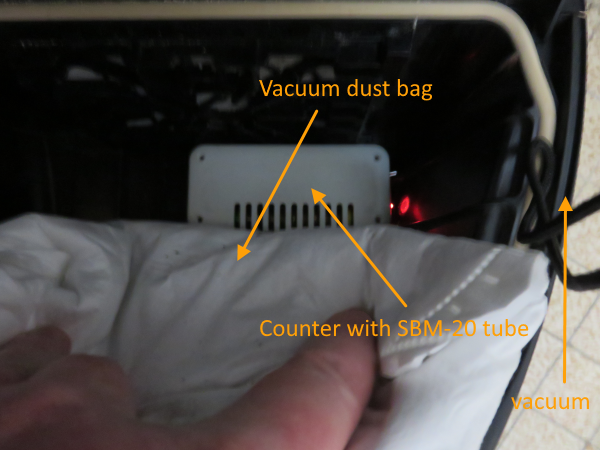
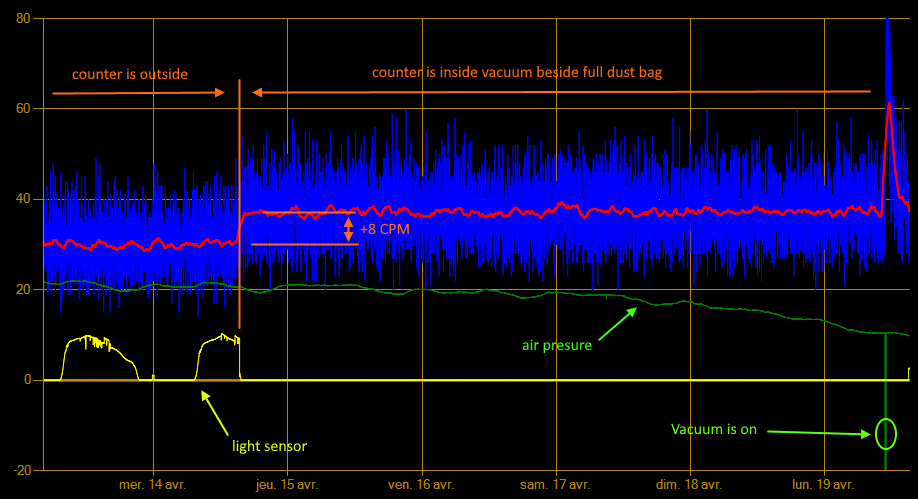
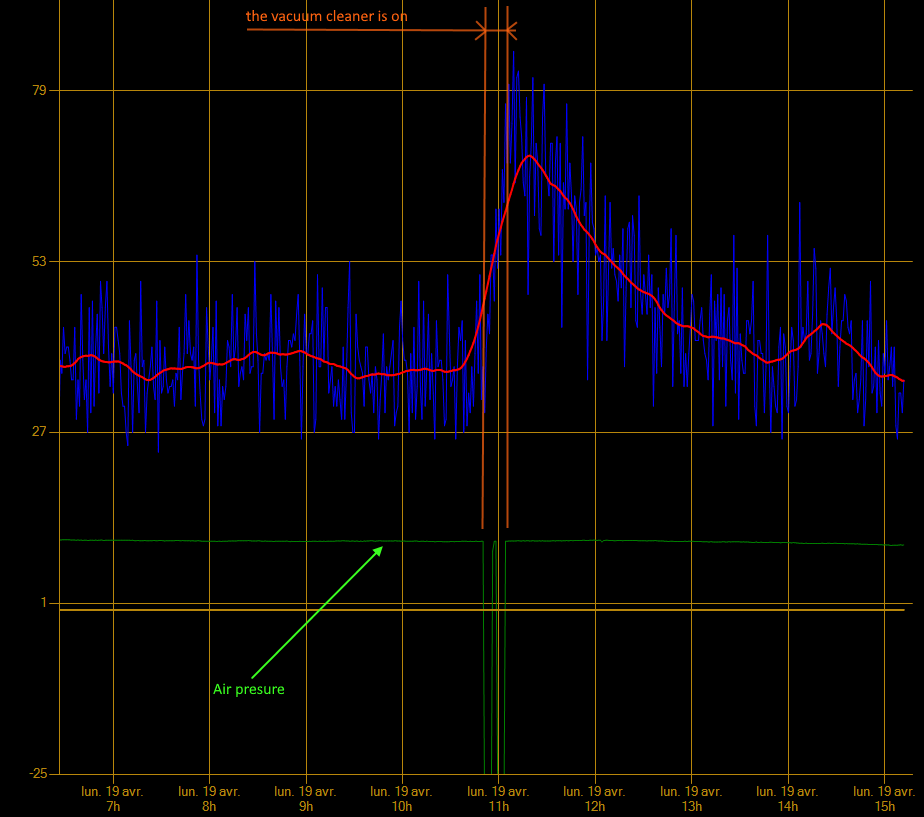 |
Mastery is acquired by studying, with it everything becomes simple |
Edited by - Damien68 on 04/20/2021 02:42:30 |
 |
|
| Reply #35
ullix
    
Germany
1237 Posts |
 Posted - 04/21/2021 : 05:51:25 Posted - 04/21/2021 : 05:51:25


|
Nice experiment!
Isn't it amazing what one can do with a simple Geiger counter and some creativity?
But what are we actually seeing there?
First: why is there a small but significant step of 8 CPM in the background? Where has the hoover been used before? In a nuclear power station?
Second: if the scale is right - why did the air pressure drop by 50% over 4 days? I don't recall a Giga-Mega-Hurricane in France in the last days (nor in any other time period)?
Third: the background did go back to the "+8 CPM" level fully?
|
 |
|
| Reply #36
Damien68
    
France
780 Posts |
 Posted - 04/21/2021 : 07:02:47 Posted - 04/21/2021 : 07:02:47


|
air presure is in hPa and is normalized to my altitude considering that I am at an altitude of 8m above the sea.
So presure is mesured presure minus 1012.28 hPa (8m altitude), so I am by the sea but no risk of tsunami for the moment, no need to go buy a snorkel :-)
for the +8 CPM, at the moment I don't know exactly where it comes from, but yes it quickly go back to the +8 CPM level, it constant and i know how to find out where it comes from, i will take two measurements but it will take a little while, and say that with an SBT-10 it would go 10 times faster. but in my opinion it is much too fragile.
|
Mastery is acquired by studying, with it everything becomes simple |
Edited by - Damien68 on 04/21/2021 23:19:07 |
 |
|
| Reply #37
Damien68
    
France
780 Posts |
 Posted - 04/21/2021 : 12:16:09 Posted - 04/21/2021 : 12:16:09


|
@ullix,
once again you are right, there is absolutely nothing detectable remaining in my filter tested 2 days after using my vacuum cleaner but I will have tested it 2 or 3 hours after the test it would have been the same thing.
I just tested it, I put my counter upside down on a table,
I waited 2 hours to measure the background,
after, I put my vacuum cleaner bag on the counter without moving the counter,
then i wait another 2 hours to measure the bag radiation, ..., absolutely nothing detectable at all.
the +8 CPM is just a variation of the background between my office and where I store the vacuum cleaner (well airy room). |
Mastery is acquired by studying, with it everything becomes simple |
Edited by - Damien68 on 04/21/2021 23:27:22 |
 |
|
| Reply #38
ullix
    
Germany
1237 Posts |
 Posted - 04/22/2021 : 00:53:14 Posted - 04/22/2021 : 00:53:14


|
So glad to hear that there are no tsunamis flooding French beaches!
What is an "EPHA" filter? A typo of HEPA? What material?
So the +8CPM is likely only a background effect from building materials. My guess is K40, which is present in many such materials https://www.bfs.de/EN/topics/ion/environment/building-materials/radionuclides/radionuclides.html
If a room's walls, floor and ceiling were of that same material, you would see the same count rate due to the K40 gamma of 1.4MeV at every position in the room.
Your vacuum was run for some 10 min, with a short break in the middle of this period. And this resulted in a count rate doubling from ~35 to 70 CPM, followed by a decline with a half life in the order of 1h.
If it were dust (from the walls) it would not disappear, so chances are for a gas like Radon. Then I would expect you see this only when vacuuming in the basement, but not when done in a well ventilated place (like outside, upper floors, ...)?
Any chance to add some charcoal filters?
|
 |
|
| Reply #39
Damien68
    
France
780 Posts |
 Posted - 04/22/2021 : 03:31:21 Posted - 04/22/2021 : 03:31:21


|
it's an average house that is 40 years old, I don't know if it's very serious but there is no basement, no crawl space, no ventilation for the foundations. there are 2 steps to climb to enter. I think they must have filled the sanitary space with sand, here there is a lot of sand and it was free.
I painted the whole house 5 years ago, I have very little dust, effectively, it more seems to be radon.
I make a mistake, it is not the dust bag which is HEPA but an independent filter which is after the turbine. In my tests I only considered the dust bag, the HEPA filter is 15 cm further away and is just a fold of multiple layer synthetic fabrics and above a foam of 1cm. I just test it, there is no radio elements on it.
but clearly if I approach the wall the CPM increases, if I approach the ground it also increases.
where my vacuum cleaner is placed, it is on the ground against a wall which explains the +8 CPM.
on my desk I have a background of 30 CPM on average, if I go to my garden I fall to around 22-25 CPM, effectively this must be due to the construction materials.
for charcoal filters I'll see if I can find some cheap in a DIY store and tape it.
Dust bag is : Handy bag S62
https://www.amazon.fr/Handy-Bag-Aspirateurs-Herm%C3%A9tique-Anti-Allerg%C3%A8ne/dp/B002YWZWHI/ref=asc_df_B002YWZWHI/

if I repeat a test I will measure the dust bag as i did and also the filter with a second counter |
Mastery is acquired by studying, with it everything becomes simple |
Edited by - Damien68 on 04/22/2021 03:32:30 |
 |
|
| Reply #40
ullix
    
Germany
1237 Posts |
 Posted - 04/23/2021 : 02:18:43 Posted - 04/23/2021 : 02:18:43


|
quote:
... here there is a lot of sand ...
Maybe you should also test the sand? I'd be surprised if you see any counts, given that it should be either Si based, or Ca based, plus O, C, and H. But sometimes also K, though rarely.
Even a HEPA filter may not catch Radon. It seems that charcoal is needed, see my link to the study referencing Rutherford in Reply #32.
Amazon.de does carry some for 6.59€, intended for kitchen hoods.
https://www.amazon.de/Carbon-Aktivierte-Schwamm-Filter-Luftreiniger/dp/B07GYRC7JV
If you used a stack of several pieces at the position of the HEPA filter in your vacuum cleaner, you could check how much passes the first layer. The dust bag may not be needed?
|
 |
|
| Reply #41
Damien68
    
France
780 Posts |
 Posted - 04/23/2021 : 11:37:16 Posted - 04/23/2021 : 11:37:16


|
Hi ullix,
The sand is OK, but it is always better to well aerate crawl spaces to ventilate the humidity but also the radon gas. and I can't. :(
There were regulations 20 or 30 years ago to limit the content of Ra226, Th232 and K40 in construction materials.
https://inis.iaea.org/collection/NCLCollectionStore/_Public/42/070/42070523.pdf
This for reference, this is low radioactive and i don't know if it detectable:
https://www.suro.cz/en/prirodnioz/building-materials
there were complaints from collectives registered a few decades ago because manufacturers liked to use radioactive waste from central or other, as components to make their cinder blocks. the manufacture of cinder block is very complex because it must be resistant to humidity, heat, frost, thermal shock, deformation, acidity caused by any mold, ..., otherwise the construction ends up like a pile of sand.
but apparently it has been done, there have been cinder blocks manufacturing with high radiation level, let's say not quite responsible even if it remains subjective. It's not my case, in any case I'm not too worried about that.
|
Mastery is acquired by studying, with it everything becomes simple |
Edited by - Damien68 on 04/24/2021 01:37:18 |
 |
|
| Reply #42
Damien68
    
France
780 Posts |
 Posted - 04/25/2021 : 08:04:30 Posted - 04/25/2021 : 08:04:30


|
if we try to extrapolate the radiation of building materials with that of salt substitutes, this gives the following result:
following previous calculation in reply 2 in the following post:
http://www.gqelectronicsllc.com/forum/topic.asp?TOPIC_ID=9114&SearchTerms=salt
240g of salt substitut activity is 2976 Bequerels.
so salt substitut activity by Kg is: 2976Bq / 240g * 1000 g/Kg = 12400 Bq/Kg
when I approche my GMC-500 to 240g of salt substitute I observe a augmentation of 60 CPM.
now consider that we have a building material of 100 Bq/Kg
in the same quantity conditions (240g), a GMC-500 should measure 60 (CPM) *100 (Bq/Kg) / 12 400 (Bq/Kg) = 0.48CPM
when measuring radiation from and close to a wall , there is more than 240g of material, but the material that is far is no longer visible.
also it would be necessary to make a calculation based around an integral.
to be quick (too bad, I wouldn't have my doctorate) we can start with an estimate with a factor 2, saying that facing a wall, a GMC-500 will receive 2 times more CPM than in front of a sample of 240g of the same material.
which therefore gives us an expected CPM increase of 0.48 CPM * 2 = +0.96 CPM
this is just a consistency calculation. In my home with a GMC-500 I observe + 4 CPM close to a wall and +8 CPM in a corner
This shows consistency, we are even in the same order of magnitude. there are several factors which can play including the activity of the wall here taken at 100Bq / Kg but which in reality could as well be 400Bq / Kg
there are also the gammas which can come from further in the wall, the factor 2 is maybe also underestimated.
this shows a possible explanation.
|
Mastery is acquired by studying, with it everything becomes simple |
Edited by - Damien68 on 04/25/2021 08:59:17 |
 |
|
| Reply #43
ullix
    
Germany
1237 Posts |
 Posted - 04/30/2021 : 00:29:23 Posted - 04/30/2021 : 00:29:23


|
If you had an infinitely - in width and height - sized wall, made of the same material everywhere, containing a bit of gamma radiating material, then you'd have the same dose rate close and remote from the wall.
I real life nothing is infinite, but walls in normal living quarters already come close. When you are in a room with 4 walls plus floor an ceiling, you should see the sum of all 6, and all dose rates being the same at every point in this 3d space.
The catch: valid for pure gamma only! Once you consider also beta emission, then dose rate depends on distance to the surfaces, because betas do get absorbed in air, depending on the energy of the betas. To calculate this becomes really challenging.
Very likely the wall, floor, ceiling material has K40 (Potassium) in some form in it. This has a hard gamma 1.4MeV emission, plus beta with a max 1.3MeV, emitted with a ratio g:b=1:9. You'd have to shield the counter from beta in order to show constant gamma in the whole room!
|
 |
|
| Reply #44
Damien68
    
France
780 Posts |
|
| Reply #45
Oldtron
 
USA
22 Posts |
 Posted - 06/06/2021 : 18:55:51 Posted - 06/06/2021 : 18:55:51


|
Hello everyone,
I’m just sit’n here soak’n up the radon…
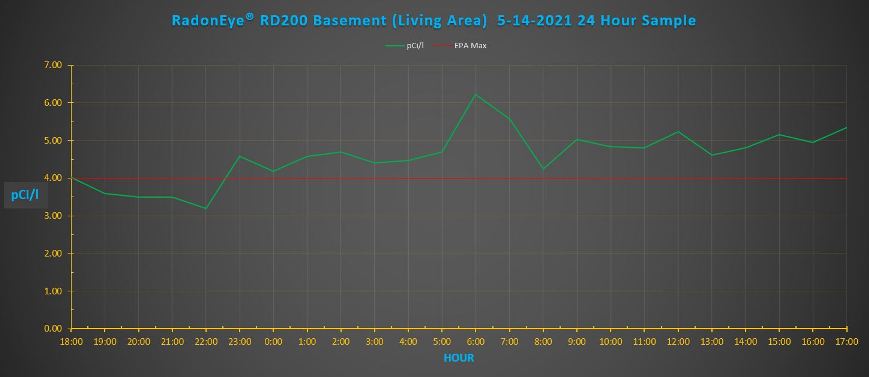
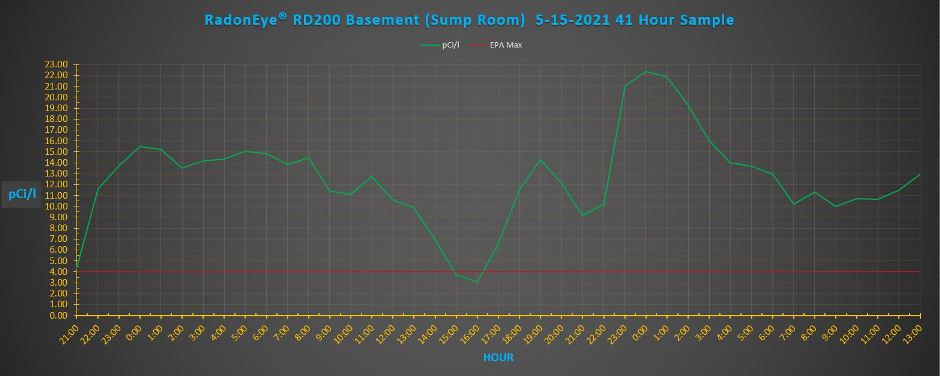
Looks like I found the source of the radiation, (like it was a big mystery).
Think 22.6 pCi/l might be a little high? Good thing I don’t spend any time in there!
So, I have a Radon Mitigation Cover for the sump, I’ll get around to sealing it up some day when my back feels better.
The most important thing is to leave a window cracked an inch or two for barometric pressure equalization, makes a big difference!
As you can imagine, in a dwelling with a sump drainage system, the dwelling sealed up tight, like in winter/summer, when the barometric pressure increases outside it’s relatively the same as the pressure inside decreasing, which sucks the radon right out of the ground and into your home. Aren’t building codes wonderful?
With the Radon Monitor, if the level gets too high, I just open the basement door, close the screen, and set a fan blowing out the bottom (fresh air coming in the top… “Do Not create negative pressure in your home if you have a similar issue!”) and in about an hour were down to background levels.
The peaks and valleys in the “sump room” graph I believe were due to a series of thunderstorms that were moving through the area at the time. Heavy rain just to the north of us seemed to correlate to the first big dip in the graph. Which seems to make sense, ground water movement through the bedrock dissolved the radon and washed it down stream. Just a theory, don’t know for sure. During this same time, I recorded no changes in barometric pressure. Would love to do more research but when I seal the sump, I’ll lose my “test sample room”, I hope.
Randy
|
A uranium atom is only three hydrogen diameters, but 238 times as massive. |
 |
|
| Reply #46
Damien68
    
France
780 Posts |
 Posted - 06/06/2021 : 22:47:06 Posted - 06/06/2021 : 22:47:06


|
Hi Oldtron,
RadonEye seeams a nice device,
Up to more than 5 times the dangerous threshold. Oupsss ..
So the old concerns with your air filter and your GMC-600 were well founded. |
Mastery is acquired by studying, with it everything becomes simple |
Edited by - Damien68 on 06/06/2021 22:53:06 |
 |
|
| Reply #47
Pcriged
 
USA
10 Posts |
 Posted - 10/20/2021 : 15:48:14 Posted - 10/20/2021 : 15:48:14


|
| I'm very interested in looking through this thread in more detail. I have been working on a similar and potentially scalable project. I would love to collaborate with any interested parties. I've been testing my filters daily for about a month. I've also taken the time to start mapping the outdoor air that is a fairly predictable range of radon from 0.5- 0.8pci/l at 5M above ground level as a means of calibration. I'm looking into the continuum radon detector as a control. My main goal this year is to establish protocol for testing, verify personal results. I love the 600plus as it's a great ballance of sensitivity and value. I've been ranging 300-400cpm outdoor air and 600-1500cpm indoors @3.7M^2/m 1Hr sample time. I'm not drawing any convulsions at this point due to a lack of control measures. |
Edited by - Pcriged on 10/22/2021 12:06:11 |
 |
|
| Reply #48
Damien68
    
France
780 Posts |
 Posted - 10/21/2021 : 01:08:30 Posted - 10/21/2021 : 01:08:30


|
@Pcriged
if you have any interesting experiments, you can share them here, they will be welcome.
|
Mastery is acquired by studying, with it everything becomes simple |
 |
|
| Reply #49
Pcriged
 
USA
10 Posts |
 Posted - 10/22/2021 : 11:52:32 Posted - 10/22/2021 : 11:52:32


|
| I have noticed a few of the above posters were concerned about the cpm rate of around 1200 cpm but the single most deterministic factor in correlation to radon level would be air flow. At 10cfm that would be a lot at 70cfm it may not depending on the filter density and the filter medium. Holmes Are1 true HEPA is a thin filter with high capture rate all the particles are held within a 1-2 mm membrane a thicker medium filter would result in less uniform alpha detection. I've been able to get almost identical Y,B readings between HEPA brands but less than uniform readings with Alpha in thicker filters. I have been able to get regular reading as high as 500CPM @ 130cfm/2 with outdoor air with a known value of 0.5-0.8PCi/l. The hardest thing I've tried to do so far is compensate for air flow, currently that means running the unit at max and calibrating based on manufacturing specifications. I'm very early into my research and it's currently on hold due to a problem with my 600+ that I'm resolving with support. |
Edited by - Pcriged on 10/22/2021 12:04:57 |
 |
|
| |
 Topic Topic  |
|
|
|

